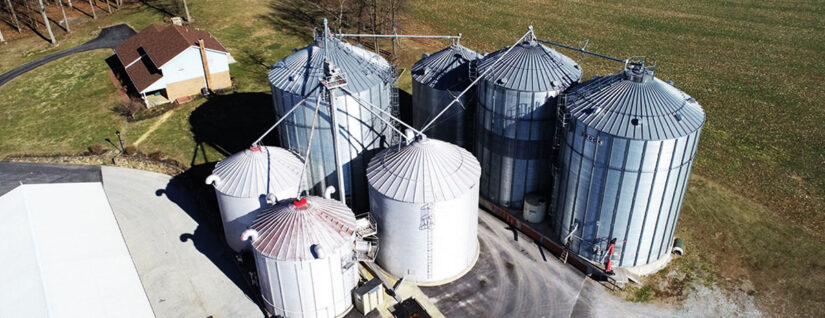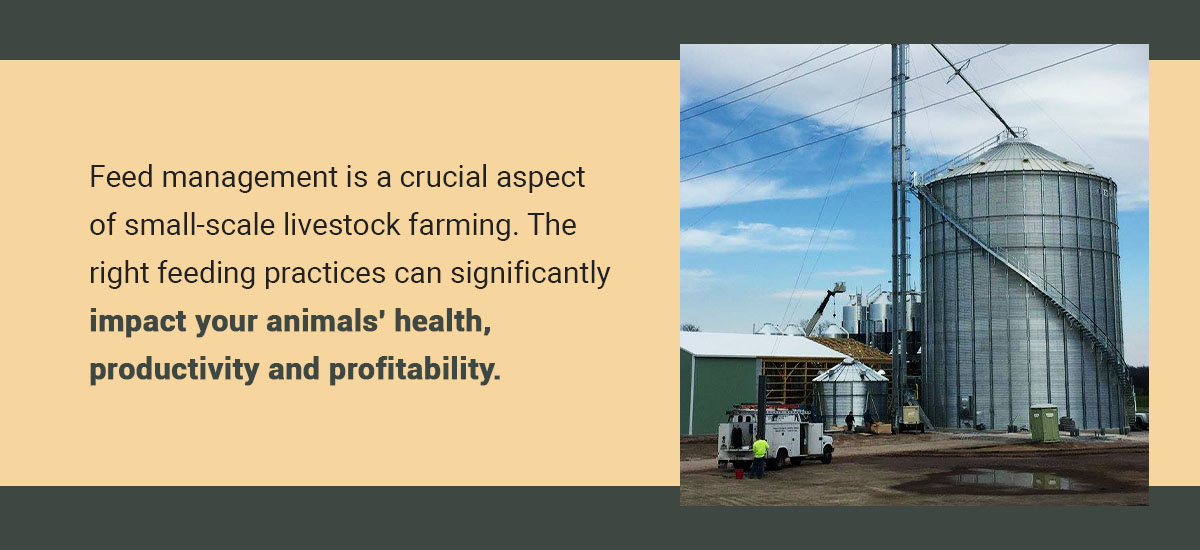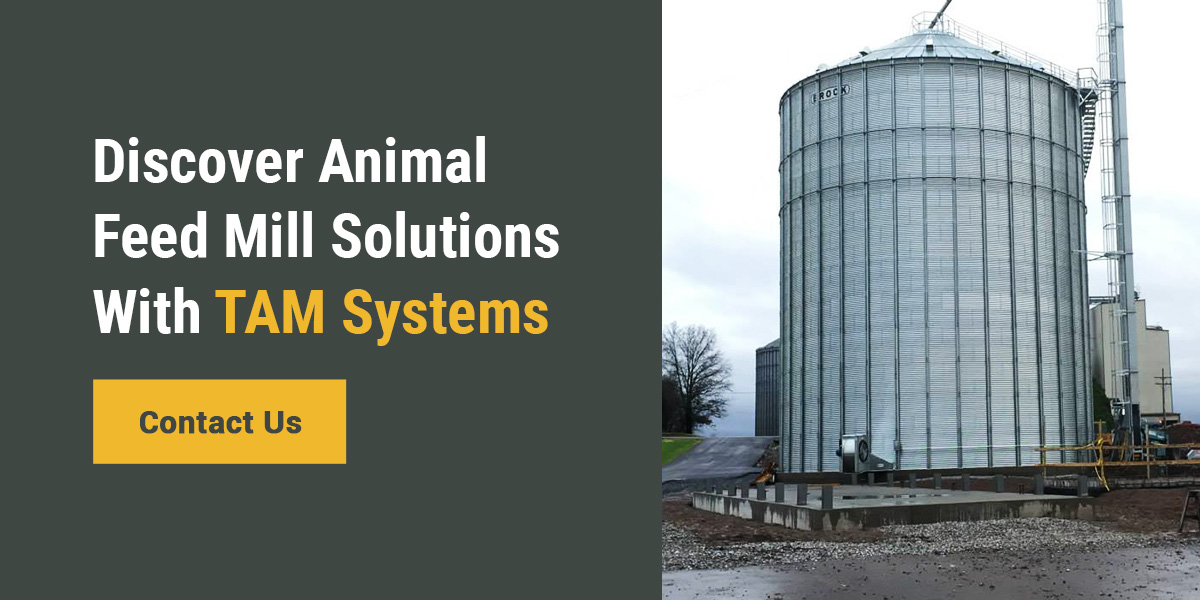In small-scale livestock farming, every detail matters. Managing a small farm feed mill efficiently is the cornerstone of ensuring your animals are well-nourished and productive. As a small farmer, you’re not just raising animals, but cultivating a sustainable livelihood. What your animals eat directly impacts their health and your farm’s success.
This blog is your guide to understanding the critical aspects of animal feed mill management, the types of equipment involved, and the processes that transform raw ingredients into nourishing animal feed. You’ll learn about small livestock farming’s unique challenges and opportunities and discover how to make the most of your animal feed mill equipment.
Join us in exploring the significance of small livestock farming and the pivotal role feed management plays. From choosing the right feed to optimizing efficiency, we’ll provide hands-on advice to enhance your feed production methods.
What Is a Feed Mill?
A farm feed mill is a facility — often located on a farm or close to it — that produces animal feed. Its primary purpose is to process raw ingredients, such as grains, soybeans, minerals and additives, into balanced and nutritious feed for farm animals. These facilities play a vital role in small- and large-scale livestock farming operations. They ensure the animals receive the essential nutrients to grow, stay healthy and produce desired outputs like meat, milk or eggs.
Farm feed mills may vary in size and capacity depending on the scale of the farming operation they serve. They typically include various equipment and machinery for grinding, mixing and sometimes pelleting the feed. These processes help create a uniform and easily digestible mixture for the animals.
In essence, a farm feed mill acts as a nutritional hub, providing a custom-tailored diet for different types of livestock. Proper feed management is essential for optimizing animal health, productivity and farm sustainability, making the feed mill a fundamental component in animal farming.
Small farmers take on a lot of responsibilities. Understanding the significance of a feed mill can save you both time and resources, ensuring your animals receive the nutrients they need without waste. A feed mill is the unsung hero that helps keep your livestock thriving.
Why Is Feed Management Important for Small Livestock Farms?
Small livestock farms play a crucial role in local food production. While these operations may not have the scale of industrial farms, their significance is undeniable. Effective feed management lies at the core of small livestock farming success. Here’s why it’s vital.
Animal Health and Wellness
First and foremost, proper feed management is essential for the health and well-being of your animals. Your feed isn’t just sustenance — it’s the building blocks of health. Balanced nutrition ensures animals receive the right mix of proteins, vitamins and minerals. This leads to healthier, more resilient livestock, reducing the risk of diseases and the need for costly interventions.
Optimized Productivity
Small livestock farms rely on every animal being productive. Whether it’s laying more eggs, producing more milk or reaching ideal weights for meat production, effective feed management directly impacts productivity. The right diet can make a significant difference in your animals’ output, directly affecting your farm’s profitability.
Economic Efficiency
Small farms often operate on tight budgets, making every dollar count. Proper feed management is a cost-effective approach. It minimizes waste, prevents overfeeding and ensures the resources invested in feed translate into tangible results. This level of economic efficiency can be a game-changer for small-scale farming operations.
Challenges and Opportunities
Small farms face challenges such as resource limitations, varying herd sizes and fluctuating budgets. However, these challenges also present opportunities. With flexibility and a personalized approach, small farms can often implement feed management strategies more efficiently than their larger counterparts. Leveraging these opportunities is key to small livestock farming success.
How Does a Feed Mill Work?
Understanding the inner workings of a feed mill empowers small-scale livestock farmers to optimize their feed production, leading to healthier and more productive animals. A feed mill relies on specialized machinery and equipment, such as grinders, mixers and pelletizers.
Knowledge of each step can be a game-changer, enabling farmers to make informed decisions about their animals’ nutrition and ultimately contributing to the success of their farms.
Raw Material Handling
Sourcing high-quality ingredients is crucial at the outset, ensuring the feed’s safety and nutritional value. Proper storage and handling are imperative to prevent contamination and preserve ingredient quality.
Grinding
This stage entails reducing the size of ingredients and adjusting moisture levels with the ultimate goal of enhancing digestibility. Various pieces of animal feed mill equipment, including attrition mills, cutters, roller mills and hammermills, are utilized in conjunction with sieves to create consistent feed particles of the appropriate sizes.
Mixing
Achieving a well-balanced feed is crucial. The mixing process combines all ingredients uniformly, promoting a consistent and nutritious blend. Various mixer types, including horizontal, vertical, revolving drum and turbine mixers, are used to ensure thorough mixing.
Optional Pelleting
Some feed mills opt for pelleting, transforming fine, dusty feed into pellets using techniques like compression and extrusion. This process involves passing the feed mixture through a chamber where a slight moisture addition aids in pelleting.
The next step involves heating, compressing and extruding these pellets through die holes. Afterward, the pellets are conveyed and subjected to drying until they reach a moisture content of approximately 13%. It’s worth noting that while pelleted feed has certain advantages, there’s a risk of losing vitamins that don’t tolerate the high temperatures generated during extrusion.
Feed Management Tips
Feed management is a crucial aspect of small-scale livestock farming. The right feeding practices can significantly impact your animals’ health, productivity and profitability. Here are some valuable feed management tips for small farmers:
- Find a nutritional balance. The feed you provide should match the specific nutritional needs of your animals. Consult a veterinarian or nutritionist to create a well-balanced diet tailored to your livestock’s requirements.
- Implement strategic feeding techniques. Some animals may thrive with free-choice feeding, while others benefit from controlled portions. Proper feeding techniques can minimize waste and overconsumption.
- Prioritize feed efficiency. Minimize waste by preventing spillage and spoilage. Using well-designed feeders, keeping feed dry and storing it properly can help reduce unnecessary costs.
- Monitor feed conversion ratios (FCR). Regularly calculate FCR to gauge how efficiently your animals convert feed into weight gain. Lower FCR values indicate more efficient feed utilization. Analyzing FCR can help you adjust your feeding strategies for better results.
- Integrate technology. Consider incorporating technology and automation into your feed management. Automated feeders, moisture analyzers and precision feed systems can save time and enhance feeding accuracy.
- Keep records. Maintain detailed records of your feeding practices, including the types of feed used, quantities fed and the performance of your animals. Keeping records lets you make data-driven decisions and continuously improve your feed management.
- Pay attention to quality control. Regularly inspect the quality of the feed you purchase, ensuring it meets the required standards and has not been contaminated. Using subpar feed can negatively impact your animals’ health and performance.
- Adapt to seasonal changes. It’s important to adjust your feeding strategies to account for seasonal variations in forage quality and availability. This flexibility ensures your animals receive consistent nutrition throughout the year.
Effective feed management is fundamental to the success of your small livestock farm. By implementing these tips, you can potentially optimize the health and productivity of your livestock while maximizing your farm’s profitability.
Discover Animal Feed Mill Solutions With TAM Systems
Your animals’ health, productivity and overall well-being are intrinsically tied to the quality of the feed they receive. As we’ve explored, a well-operated feed mill is key to producing nutritious feed that maximizes your farm’s potential. Mastering feed mill management for small farms is vital.
At TAM Systems, we understand the unique challenges small farmers face in managing their animal feed. That’s why we offer customized feed bin systems that provide ample storage capacity, easy operation and advanced features to optimize feed management. We’re passionate about helping you elevate your farming practices.
Take the first step toward enhancing your feed management — contact us online today. Your livestock and your bottom line will thank you.




